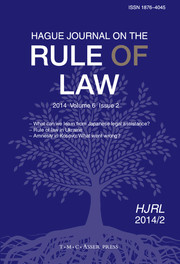No CrossRef data available.
Article contents
Editorial: Developing the Rule of Law in East Asia
Published online by Cambridge University Press: 10 October 2013
Extract
This special issue results from a conference called ‘The State in Asia’, which was held in Leiden from 17-19 December 2012. The overall theme of the conference was the development of modern states in Asia, conceptualised as ‘ongoing projects informed by a quest for cultural, religious and political identities that are new and modern, yet simultaneously rooted in indigenous culture and tradition’. The formation and the functioning of Asia's systems of law and governance reflect strong developmental ambitions as well as deep heterogeneity and insecurity. In the East Asian context Japan, Singapore, and South Korea now serve as models of successful nation-states that other states in the region aspire to emulate, but in most countries in the region endemic corruption and factionalism make rule anything but stable and predictable.
The panel on ‘Developing the Rule of Law’ looked at the attempts to realise different aspects or elements of the rule of law in East Asia. In this effort East Asian states have borrowed paradigms, ideas and laws from elsewhere which may take on quite different meanings in their new surroundings. Regional models, have become more important than they were in the past, but ideas are adopted from all over the world. The rise of ‘alternative’ global and regional legal regimes has reinforced this process and led to a situation where states may choose to model their laws and legal institutions from a much broader range of examples than in the past.
- Type
- Editorial
- Information
- Copyright
- Copyright © T.M.C. Asser Press and the Authors 2013


